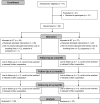Addressing Self-Control Cognitions in the Treatment of Trichotillomania: A Randomized Controlled Trial Comparing Cognitive Therapy to Behaviour Therapy
- PMID: 27471331
- PMCID: PMC4947120
- DOI: 10.1007/s10608-016-9754-4
Addressing Self-Control Cognitions in the Treatment of Trichotillomania: A Randomized Controlled Trial Comparing Cognitive Therapy to Behaviour Therapy
Abstract
People with trichotillomania often have persistent negative beliefs about giving into one's habit. Central in the present study was the hypothesis that the follow-up effects of cognitive therapy (CT), in which these negative beliefs are directly addressed, are better compared to the follow-up effects of behaviour therapy (BT). Fifty-six trichotillomania patients were randomly assigned to either six sessions CT or BT. Forty-eight completed their treatment. Follow-up measurements took place after a 3 months treatment-free period, and at 12 and 24 months. CT and BT both resulted in clear reductions of trichotillomania symptoms (severity, urge, inability to resist, and negative beliefs) immediately after treatment. There were no differences between the groups. Following the treatment-free period, there was a reoccurrence of symptoms. In contrast to our expectation, we failed to show that CT compared to BT resulted in lower relapse rates after the treatment-free period.
Keywords: Behaviour therapy; Cognitive therapy; Randomized controlled trial; Trichotillomania.
Figures
Similar articles
-
Behavior therapy for pediatric trichotillomania: a randomized controlled trial.J Am Acad Child Adolesc Psychiatry. 2011 Aug;50(8):763-71. doi: 10.1016/j.jaac.2011.05.009. Epub 2011 Jul 1. J Am Acad Child Adolesc Psychiatry. 2011. PMID: 21784296 Free PMC article. Clinical Trial.
-
Behavioural treatment of trichotillomania: two-year follow-up results.Behav Res Ther. 2006 Mar;44(3):359-70. doi: 10.1016/j.brat.2005.03.004. Epub 2005 May 31. Behav Res Ther. 2006. PMID: 15927144 Clinical Trial.
-
A Preliminary Investigation of Metacognitive Therapy and Habit Reversal as a Treatment for Trichotillomania.Behav Cogn Psychother. 2018 Jan;46(1):1-20. doi: 10.1017/S1352465817000546. Epub 2017 Sep 14. Behav Cogn Psychother. 2018. PMID: 28903787 Clinical Trial.
-
Trichotillomania (hair pulling disorder).Indian J Psychiatry. 2019 Jan;61(Suppl 1):S136-S139. doi: 10.4103/psychiatry.IndianJPsychiatry_529_18. Indian J Psychiatry. 2019. PMID: 30745687 Free PMC article. Review.
-
Psychological treatments for trichotillomania: update and future directions.Australas Psychiatry. 2015 Aug;23(4):365-8. doi: 10.1177/1039856215590029. Epub 2015 Jun 23. Australas Psychiatry. 2015. PMID: 26104780 Review.
Cited by
-
Trichotillomania and Trichophagia: Modern Diagnostic and Therapeutic Methods.Dermatol Ther (Heidelb). 2018 Sep;8(3):389-398. doi: 10.1007/s13555-018-0256-z. Epub 2018 Aug 11. Dermatol Ther (Heidelb). 2018. PMID: 30099694 Free PMC article. Review.
-
Long-term follow-up of acceptance-enhanced behavior therapy for trichotillomania.Psychiatry Res. 2024 Mar;333:115767. doi: 10.1016/j.psychres.2024.115767. Epub 2024 Jan 30. Psychiatry Res. 2024. PMID: 38330639 Free PMC article.
-
Comprehensive Behavioral Therapy of Trichotillomania: A Multiple-Baseline Single-Case Experimental Design.Front Psychol. 2020 Jun 10;11:1210. doi: 10.3389/fpsyg.2020.01210. eCollection 2020. Front Psychol. 2020. PMID: 32587552 Free PMC article.
References
-
- American Psychiatric Association . Diagnostic and statistical manual of mental disorders-IV-TR. Washington, DC: American Psychiatric Association; 2000.
-
- Azrin NH, Nunn RG, Frantz SE. Treatment of hairpulling (trichotillomania): A comparative study of habit reversal and negative practice training. Journal of Behavior Therapy and Experimental Psychiatry. 1980;11:13–20. doi: 10.1016/0005-7916(80)90045-2. - DOI
-
- Baumeister RF, Heatherton TF, Tice DM. Losing control: How and why people fail at self-regulation. San Diego, CA: Academic Press; 1994.
-
- Baumeister RF, Muraven M, Tice DM. Ego depletion: A resource model of volition, self-regulation, and controlled processing. Social Cognition. 2000;18:130–150. doi: 10.1521/soco.2000.18.2.130. - DOI
LinkOut - more resources
Full Text Sources
Other Literature Sources


